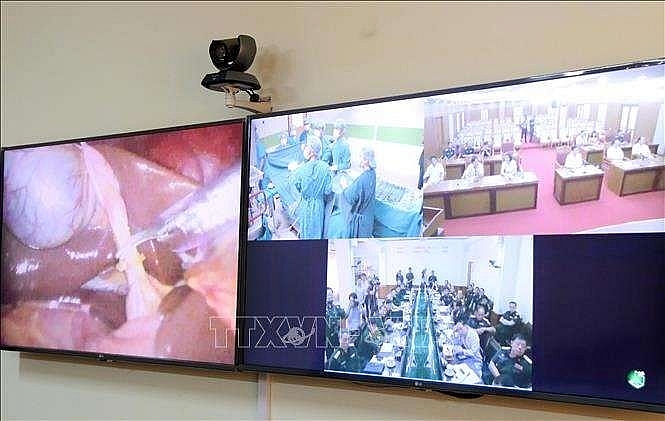Telemedicine connects doctors, saves lives
 |
| A telemedicine system that helps connect doctors in different hospitals.-VNA/VNS Photo |
According to the Ministry of Health’s Information and Technology Department, telemedicine networks have been developed and expanded in the country. For example, Bach Mai Hospital offers medical examination, consultation and treatment to provincial general hospitals in Bac Giang, Vinh Phuc, Thai Binh, Thanh Hoa, Ha Tinh, Lao Cai, Ninh Binh, Hoa Binh, Phu Tho, Quang Ninh and Saint Paul Hospital in Hanoi. While, Vietnam-Germany Hospital is connected to general hospitals in Ha Giang, Quang Ninh, Ninh Binh, Thai Binh, Dien Bien, Lao Cai and Bac Giang.
Doctor Nguyen Duc Tien from Vietnam-Germany Hospital said the hospital has organised training courses for doctors of satellite hospitals and offered telemedicine for the hospitals.
Telemedicine helps doctors in operating surgeries and diagnosis rooms connect regardless of geographic distance, thus speeding up treatment and helping to save patients, he said.
The Vietnam-Germany Hospital uses telemedicine to connect with hospitals in 18 cities and provinces across the country so that patients receive proper medical examination and treatment at their local hospital instead of traveling to the central hospital.
Patients received prompt medical treatment, which helped them save time and costs, while the central hospital like Vietnam-Germany Hospital reduced overcrowding, Tien said.
A few months ago, Tien said doctors from Vietnam-Germany Hospital and Dien Bien General Hospital in the northern mountainous province collaborated to save a 31-year-old male patient suffering from serious brain damage.
Poor weather conditions and the long distance, in addition to the urgency of the situation, prevented doctors from transferring the patient to Vietnam-Germany Hospital. Meanwhile, it would take too long for doctors to travel from Hanoi to Dien Bien.
Tien said that telemedicine proved its advantages and effectiveness in that case because top surgeons from Việt Nam-Germany Hospital directed the surgery for the patient. The surgery, which is usually beyond the ability of provincial-level hospital, was performed successfully.
In another case, Bac Giang General Hospital in the northern province of Bac Giang, and E Hospital in Hanoi, collaborated on saving a 35-year-old female patient suffering from a heart defect. The woman was taken to Bac Giang General Hospital with broken ribs, pale skin and doctors were unable to measure her blood pressure. Thanks to co-operation between the two hospitals, the female patient underwent surgery and survived.
Earlier this month, Ca Mau Obstetrics and Pediatrics Hospital in the southernmost province of Ca Mau sent their colleagues in HCM City’s Children Hospital 1 videos and test results of a 2-year-old boy who had hand-foot-mouth disease.
During the night, doctors of the two hospitals held a consultation and decided to transport the boy to HCM City as soon as possible.
Head of HCM City’s Children Hospital 1 Pham Van Quang said that the boy was in such a critical condition that he needed a complicated technique – Hemodialysis – that was not available at Ca Mau Hospital.
Quang said that doctors at Ca Mau Hospital was instructed to provide a breathing machine, medicine, equipment and update the boy’s condition for Children’s Hospital 1 during the 300km trip from Cà Mau to HCM City.
“The boy arrived in HCM City safely and then received proper medical treatment,” Quang said.
These three cases are among hundreds in which telemedicine helped doctors from different hospitals work together to save patients.
An official from the health ministry’s Information and Technology Department, Tran Van Tuyen, told baogiaothong.vn that next year the ministry would provide telemedicine systems at 26 health centres at the communal and ward level under a pilot programme.
The commune and ward healthcare centres would connect with hospitals at higher levels including district, provincial and national hospitals. As a result, the healthcare centres could receive professional medical consultations quickly with available equipment and internet connections.
This connection is expected to improve the service quality of commune/ward healthcare centres and reduce overcrowding at central hospitals.
According to the ministry, 35.4 per cent of patients who go to central hospitals should be treated at province-level hospitals and 20 per cent of them should be treated at district-level hospitals.
Over 41 per cent of patients who go to province-level hospital should be treated at district-level hospital and 11 per cent of them should be treated at commune/ward healthcare centres.
What the stars mean:
★ Poor ★ ★ Promising ★★★ Good ★★★★ Very good ★★★★★ Exceptional
Related Contents
Latest News
More News
- Protect what’s next: towards a future free from meningococcal group B disease (December 05, 2025 | 18:00)
- New ILO report offers policy recommendations for disability inclusion (December 04, 2025 | 15:18)
- Maternal job loss may affect children’s mental health, research shows (December 03, 2025 | 19:11)
- Women lead Vietnam’s shift to climate-resilient agriculture (December 03, 2025 | 19:10)
- Experts highlight unpaid care work as key barrier to gender equality (December 03, 2025 | 15:15)
- Opportunities and inequalities for women workers in Vietnam's garment industry (December 03, 2025 | 09:00)
- Vietjet flights carry love to devastated central region (November 28, 2025 | 11:35)
- New initiative to boost the fight against domestic violence (November 26, 2025 | 10:00)
- South Korea funds IOM relief for Vietnam’s typhoon-affected communities (November 24, 2025 | 15:33)
- AI and human-centred values set to shape the future of HR in Vietnam (November 21, 2025 | 18:04)

 Tag:
Tag:






















 Mobile Version
Mobile Version